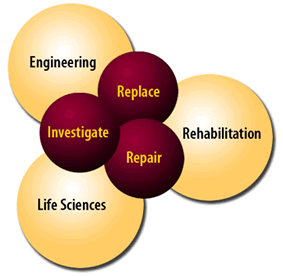About ANS
Overview
Traumatic injury or neurological diseases can significantly alter or impair the lifestyle of the afflicted individual. Driven by the needs of potential users, our engineers and scientists at the Center for Adaptive Neural Systems (ANS) are designing and developing technology to offset the effects of spinal cord injury, orthopedic injury, Parkinson’s disease and cerebral palsy. Applying a multifaceted approach, the center seeks to investigate the effects of trauma and disorders of the nervous system, to replace damaged or lost functionality, or to repair the system using advanced adaptive devices and therapeutic techniques.
ANS is focused on developing and utilizing new scientific knowledge and engineering technology to address the complex physiological, medical and societal problems presented by neurological disability. Its research agenda is at the intersection between bioengineering, neuroscience and rehabilitation.
The multidisciplinary team is made up of engineers, clinicians and scientists with a wide range of expertise from electrical, mechanical and biomedical engineering, to neurosurgery and physical therapy, and neuroscience, physiology, exercise science and kinesiology. This multifaceted team works together to address problems of neurological disabilities at multiple levels from molecular/cellular physiology through neural circuitry, systems neurophysiology, to musculoskeletal physiology and behavior. The goal of this research is to deliver advanced medical technology. The scope of the center’s activities includes the design and development of new technology, the evaluation of technology in whole animal and human subject trials, and the transfer of these technologies to biomedical industry and clinical practice.
Neural prostheses and advanced prosthetic systems
For many individuals with spinal cord injury, limb loss, or Parkinson’s disease, new technology can help to restore mobility and functionality. Researchers at ANS are designing and developing new neural prostheses and advanced mechanical prosthetic systems. Several projects are directed at translating research results from the laboratory in order to deliver practical systems that can be readily utilized on a daily basis.
Neuromorphic control systems
Legged locomotion and object manipulation are examples of activities that routinely are performed by biological systems in a highly functional and elegant manner. Neuromorphic engineering seeks to utilize biological designs, specifically architectural and operational principles of neural system function, in order to develop improved engineered systems. At ANS, we are designing algorithms and electronic circuits that mimic the functionality of neuromotor control systems. In collaboration with our commercial and clinical partners, we are translating the result of these engineering design efforts into practical systems to provide improved mobility and exercise options.
Adaptation in neural systems
The ability of neural systems to adapt enable biological systems to learn to interpret sensory information and to produce functional movements. At ANS, we are developing therapies and technologies that seek to guide these adaptive processes to maximize the recovery of function after trauma or neurological disorders.
Why is our research important?
Disability has a broad impact on the individual, the health care system and society. In the U.S. and around the world, disability often results in decreased quality of life due to medical complications, poor general health and physical fitness, reduced independence, and limited employment options. Neurological disabilities are devastating in terms of their impact on lifestyle, the duration of their impact and the costs associated with the disability.
The center’s research is motivated by the prevalence of neurological disorders, the severity of their effects, and the perceived opportunity to impact the practice of medical rehabilitation through the use of technology.
The growing need for medical neurotechnology is being fueled by our aging society and a growing interest in the use of medical technology not only to extend life, but perhaps more importantly, to improve the quality of life.
